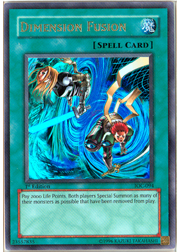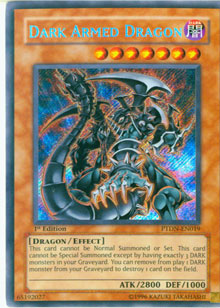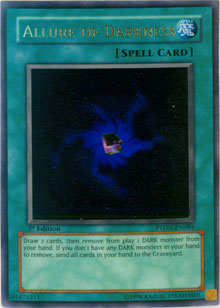Finally.
Since the release of Phantom Darkness, competitive dueling has gotten faster and faster. When Dark Armed Dragon hit the scene—bolstered by the dual draw engine of Allure of Darkness and the Destiny Hero suite—the concept of speed in this game was utterly redefined. Decks like those played at Shonen Jump Championship Houston
by Adam Corn, Paul Levitin, and James Neumann set the trends for coming months, and after Dark Armed Return’s victory at Costa Mesa things only got faster. Players became more and more interested in either increasing the deck’s speed or finding an FTK that could end the game on turn 1 altogether.
At Shonen Jump Championship Columbus this trend came toa head, as Jerry Wang’s Dark Armed Return variant (fueled by Cyber Valley’s draw power) narrowly took down Erin Diaz’s Shadowpriestess of Ohm FTK strictly due to Crush Card Virus. The finals of a Shonen Jump Championship played out in just six short turns.
While Dark Armed Return and the wide variety of OTK and FTK decks weren’t an invincible strategy (as evidenced by Paul Levitin’s Gladiator Beast win in Minneapolis), they were still an overwhelming presence. The sheer speed these decks created made it impossible for many other strategies to compete, and that became a big stumbling block for duelists.
But it seems like that’s all over now! UDE R&D’s Dan Scheidegger posted an announcement from Organized Play yesterday on the official forums, announcing three mid-format changes that should widen the playing field for the slew of upcoming Shonen Jump and National Championships. The announcement is transcribed here:
Yu-Gi-Oh! TCG Organized Play
Important Announcement: Forbidden & Limited List Changes
Attention all Yu-Gi-Oh! TRADING CARD GAME players, judges and tournament organizers: To continually promote a diverse and enjoyable play environment, a few changes have been made to the Official Forbidden & Limited Lists. The changes are below and are effective for all sanctioned tournaments starting May 9th, 2008.
Duelists cannot include a Forbidden card in their Deck. Only one copy of a Limited card and up to 2 copies of a Semi-Limited card can be included in a Deck.
Personally, I’m pretty happy. I’m sure somebody on some message board will call me a shill for lauding these changes, but while I’ve got your ear I think it’s a good chance to discuss the apparent impact of each: both individually and as a whole.
Dimension Fusion Gone
I think this was at the top of everybody’s list—virtually no one wanted to see Dimension Fusion sticking around. On its own, Dimension Fusion was a card that let you randomly win  games that would otherwise be unwinnable, often far faster than most players thought was fair. That was how this card functioned in most Dark Armed Return decks—a huge finishing blow that gave instant card and field presence for a negligible cost.
games that would otherwise be unwinnable, often far faster than most players thought was fair. That was how this card functioned in most Dark Armed Return decks—a huge finishing blow that gave instant card and field presence for a negligible cost.
But that wasn’t Dimension Fusion at its worst. Erin Diaz’s deck and strategies like it were where this maligned spell card became truly painful, looping Dark Magician of Chaos and Cyber Valley cards to create infinite draw loops. The result was a shocking number of decks like Shadowpriestess OTK, Tundo OTK, and even decks that performed finite loops just to get a few extra cards like Magical Explosion OTK. It’s probably no revelation coming from me weeks after the fact, but it bears saying: this card created games where one player never even got to take a turn.
And now it’s over. While some OTK strategies remain (such as a weakened Explosion OTK or the foreseeable Batteryman decks), there aren’t any FTK’s left. The combo decks that do remain are slower than they were, meaning you’ll have time to draw that sided Ring of Defense or just to win thanks to disruption and clever tactics. It’s a pretty cut-and-dried issue: the game’s biggest combo card is gone, and with it go the broken combo decks.
What isn’t so cut-and-dried is the impact of this change on Dark Armed Return. To examine that, we’ll need to look at the second change to the current Advanced list.
Return from the Different Dimension to One Per Deck
It’s no secret: while there have been plenty of decks that have run Return in the past, the only Shonen Jump Day 2 appearances lately have been in Dark Armed variants. Together, Return from the Different Dimension and Dimension Fusion were capable of bringing even the most committed and complicated games to a close, thanks to the combined effects of Dark Magician of Chaos, Darklord Zerato, and Jinzo. While Dark Armed Dragon itself is an  exceedingly good card that created big swings in card presence, it didn’t normally win the game on its own: something Dimension Fusion and Return were both capable of doing as early as turn 2.
exceedingly good card that created big swings in card presence, it didn’t normally win the game on its own: something Dimension Fusion and Return were both capable of doing as early as turn 2.
I think it’s pretty obvious that that’s what these changes were all about: slowing down those early wins that were driving so many strategies out of the game (and driving duelists nuts in the process). While Dimension Fusion was the worst part of that problem (since it was proactive and didn’t require a turn’s time on the field like Return), its Limited status kept it from creating a consistent finishing plan. Its second-rate cousin playable in three, Return, is really what let the deck consistently OTK and go from nothing to a full field. With that in mind, Return obviously needed to be hit too.
The decision to place Return at one per deck instead of just Forbidding it outright will probably be debated. On one hand, keeping Return at one has drawn some cries of "now it’s just a lucksack card!" I’ll admit it: that was my first reaction, and it’s true that Return can be an awesome topdeck—if you can buy yourself a turn and keep it on the field. But I noticed a differing opinion that a few people have voiced in online communities: if Return is Limited, it means that when you play against a deck using it, you can anticipate the card and play accordingly (much as players do in the case of Mirror Force or Torrential Tribute). I think that view has a lot of legitimacy in an era where Gladiators and the Lightsworn are poised to bring more spell and trap removal to the game than we’ve ever seen in the past.
So what does the removal of Dimension Fusion and the Limiting of Return mean for Dark Armed duelists? Not much, and I can’t help but think that was kind of the point. The deck is definitely slower and less explosive, but it still exists, and can still win a commanding number of games. The average Dark Armed player is probably just going to swap out his or her Dimension Fusion and one or two copies of Return for two copies of D.D.R. - Different Dimension Reincarnation. The Dark Armed players will then go on playing almost exactly as they did before: they just won’t win quite as quickly and they won’t be relying on an explosive flood of summoning. That difference means that decks like Jerry Wang’s—which was arguably more dependent on Fusion or Return—are likely to be deemed less competitive than progenitor builds like those piloted earlier by James Neumann and Adam Corn. With fewer copies of Cyber Valley out there, Light and Darkness Dragon is more of a  threat. Graveyard management becomes more important because Dark Armed Dragon itself becomes more important. That’s just one of several reasons why Necro Gardna’s stock in the deck may rise (another would be the fact that Different Dimension Reincarnation makes Dark Magician of Chaos a more common sight). All in all, the deck will now present its user with more decisions and more interactions: there won't be the reliable option of just going on autopilot and winning with a big special summon card.
threat. Graveyard management becomes more important because Dark Armed Dragon itself becomes more important. That’s just one of several reasons why Necro Gardna’s stock in the deck may rise (another would be the fact that Different Dimension Reincarnation makes Dark Magician of Chaos a more common sight). All in all, the deck will now present its user with more decisions and more interactions: there won't be the reliable option of just going on autopilot and winning with a big special summon card.
The main difference when everything's said or done is speed: decks that didn’t win until turn 5, 6, or later now have a far better shot. That consideration brings us to the third item in the list of mid-format changes.
Allure of Darkness to Two Per Deck
The speed of the OTK and Dark Armed decks was leveraged into mass-special summoning cards, but it was fueled by incredible draw power. Reducing Allure to two per deck reduces  the speed of these strategies by a nominal margin, while performing the secondary function of also keeping Different Dimension Reincarnation slightly checked. Overall this is definitely the least important of the three changes, but once Reincarnation and Escape from the Dark Dimension start seeing more play, that third Allure is going to be missed.
the speed of these strategies by a nominal margin, while performing the secondary function of also keeping Different Dimension Reincarnation slightly checked. Overall this is definitely the least important of the three changes, but once Reincarnation and Escape from the Dark Dimension start seeing more play, that third Allure is going to be missed.
I think it’s worth it to note that of the three cards restricted, only Allure is relatively new. A lot of people were calling for Limitations on Dark Armed Dragon itself, or the Forbidding of Dark Magician of Chaos. I think that type of move would have been ineffective from a strictly game-oriented view—many duelists have shown that Dark Return without Dark Armed Dragon was still exceptionally frustrating—but I also think it would’ve been terrible for the players. Plenty of us spent our hard-earned dough to get Dark Armed Dragon and Allure, while Forbidding Dark Magician of Chaos would’ve hurt anyone who was lucky enough to pull one from Gold Series. Punishing players for running new cards would’ve been a negative move for everybody—both the people who make the game and those of us who play it—so I’m glad to see that Allure to two is the only move in that direction. For players who don’t own Allure yet, the newfound surplus should make them a lot easier to get.
Thoughts and Trends Arising From the Changes
The big impact of these changes is simple to see: players who didn’t want to run Dark Armed Return or OTK strategies now have the opportunity to play what they want, while Dark Armed duelists can still run their current deck after making a handful of low-cost tweaks. The deck is more challenging to play, but its potential is still exceptionally high in the hands of a skilled player. Meanwhile it’s a lot safer to invest in a Lightsworn or Gladiator Beast deck with cards from Light of Destruction, because we now know that those decks will be fast enough to compete. Older strategies that were previously lauded for their quickness, such as Zombies and Six Samurai, might also see more time in the spotlight. From there on out, there’s a nebulous cloud of decks waiting to be discovered (or just rediscovered) that could now win Championship tournaments. The doors are wide open.
But beyond that broad change are a ton of smaller ones. Since players don’t need to fear OTK’s nearly as much as before, flip effect monsters gain a ton of viability—this is especially relevant for Ryko, Lightsworn Hunter, a card Lightsworn duelists would really like to play in threes. Gladiator Beast Hoplomus becomes a safer turn 1 play, and I wouldn’t be surprised if we see slow-tempo monsters like DUCKER Mobile Cannon, Dekoichi the Battlechanted Locomotive, and Magical Merchant making first appearances or comebacks in the right strategies. I expect Nobleman of Crossout to see play again based strictly on Ryko and Heraklinos alone, while Ehren, Lightsworn Monk gets a whole lot better too.
A slower average speed with more turns played per duel may also mean the return of Skill Drain. With Angel O7 released as a secret rare in Light of Destruction, duelists can now double the amount of effect negation they ran before, without resorting to Destiny Hero - Plasma. The Angel can be summoned with its effect for a single tribute if you give up Gellenduo, so it’s actually quite viable, especially if the average competitive metagame skews toward Dark Armed Dragon, Lightsworn, and Gladiator Beasts as many are expecting.
Since the average duelist won’t be making nearly so much use of his or her removed-from-play pile either, it’s safer to remove monsters from play again: while you might have to worry about that monster coming back, it won’t come back with any friends to gang up on you. That may signal the emergence of Caius the Shadow Monarch into competitive play, something that was previously ruled out by the speed of the format and repeated appearance of Return and Dimension Fusion. Macro Cosmos is a lot more stable too, and—combined with the graveyard dependency of some Lightsworn and Gladiator Beast builds—we may see a lot more remove-from-play strategies being played again.
The big impacts of these changes are obvious, and it would be difficult to argue that they aren’t uniformly positive. The smaller details are where things really get interesting though, and anyone who can master them and make the right predictions may have a very successful showing at their upcoming National or Shonen Jump Championships. The month of May marks the beginning of a long string of high-level title events, and these changes are going to create an environment that’s very much in the favor of skilled duelists who can adapt.
The era of speed is over, and I for one can’t wait for the weekend. Light of Destruction won’t be legal yet, but the changes to the Advanced list will be in effect for Shonen Jump Championship Nashville this Saturday, so join us as we bring you live extended coverage from the tournament. Everybody’s got their theories, but the reality arrives mere hours from now—dueling history will be made in Nashville, and a new era is definitely upon us.
—Jason Grabher-Meyer